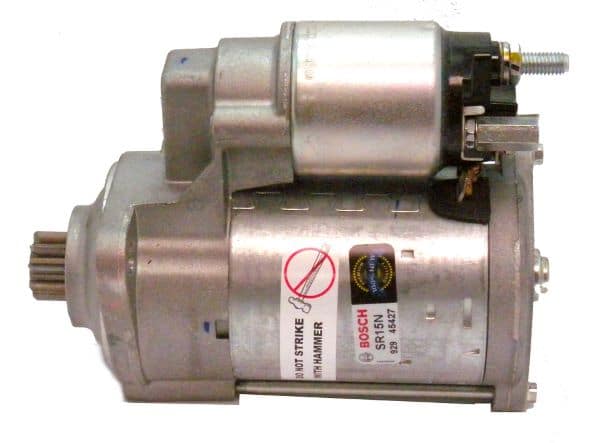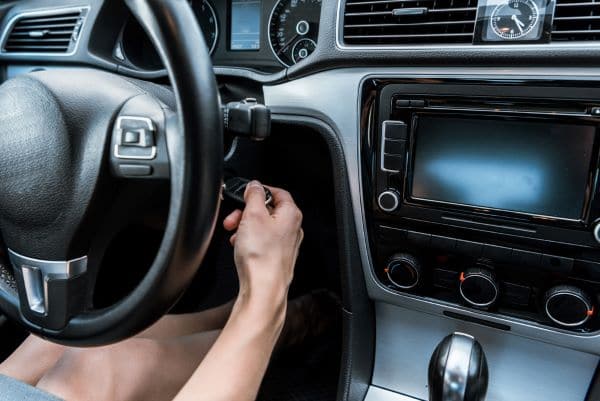There are many reasons that a car might not start, but one of the most popular is when the starter goes bad. If you are facing intermittent starting problems or you can’t seem to crank the engine over, you might be banging your head against the steering wheel in frustration. We look at how to start a car with a bad starter and explain some of the bad starter relay symptoms.

What does a bad starter sound like and what can be done about it? We cover all of these concerns and give you some invaluable advice.
Table of Contents
What is the Starter?
The car starter is an electrical motor that is responsible for starting the engine. The starter receives the power it requires from the car battery. After you turn the key in your ignition, the battery sends out an electrical current to the starter solenoid.
The starter solenoid is inside the starter motor, responsible for transferring power to the starter. As the starter receives an electrical current from the car battery, a gear extends from the starter to engage the flywheel in the vehicle.
As the flywheel engages, it turns the crankshaft of the engine. This is what transfers power to the motor. Once the engine is started, the small gear inside the starter disengages from the flywheel and goes back into the starter assembly.
Here are the major parts of the starter.
- Electromagnetic Field Coils and Housing: The starter housing is a field frame with a core. Cars can contain two to four field coils, all connected in a series.
- Armature: This soft laminated core is wrapped in windings or loops. On the conductor end, you will find commutator bars with carbon copper bushes that transfer voltage and create an electrical contact.
- Solenoid: A solenoid contains two coils of wire that are wrapped around the movable core. The solenoid works like a switch that connects the starter motor to the car battery.
- Shift Fork: The shift fork is pulled or pushed by the solenoid to engage the starter gear.
5 Bad Starter Symptoms
Trying to figure out if you are dealing with bad starter relay symptoms or bad ground on amp symptoms requires you to look at what happens when you turn the key in the ignition. Here are the top five things that can happen as the starter fails.

Car Doesn’t Start But Has a Fully Charged Battery
When your vehicle won’t start, you face the most common symptom of a failed starter. If you check the battery and it is fully charged, you know that this isn’t holding up the starting power. The next logical explanation would be the starter.
Another way to tell that it is the starter causing problems is to try out the electrical parts of the vehicle. If you can turn the ignition to the on position and run the headlights or other electronic equipment, the battery is not your problem.
Unusual Clicking Noises
A bad starter makes a distinctive clicking sound. If you are trying to start the engine but only hear this noise, the starter is probably to blame.
However, you can also hear some clicking if you are dealing with a dead car battery. To determine which is to blame, test the charge in the battery first.
Slower Starting Speeds
If the car starts sometimes after trying more than once, you might have caught the starter when it is failing. You might also have trouble starting the car when the engine is hot.
Only you know how long your vehicle typically takes to start. What might be normal for one might reveal a problem in another vehicle.
Starter Soaked with Oil
This problem isn’t as noticeable as some of the others unless you take a peek under the hood. Engine oil leaks can often lead to a malfunctioning starter when contamination occurs.
If you look at the starter and find it drenched in oil, you know where the problem lies. While you might be able to clean up the starter to get the car moving, the issue won’t be resolved until you stop the oil leak.
Starter Remains Engaged with the Flywheel
If your vehicle is making a whining noise after starting, it could be due to the engagement with the flywheel. When the starter stays engaged after the motor starts, the starter might be failing.
If the starter doesn’t disconnect from the flywheel after the engine starts, you are going to know it. At first, the sound might be alarming, but it just means you have warning that the starter is failing.
How to Start a Car with a Bad Starter: 5 Ways Revealed
Starting a car with a bad starter isn’t the easiest task to accomplish. In many cases, you may need to have the starter replaced to get back on the road. However, we have five tips for you that might help. If you want to know how to start a car with a bad starter, walk through these steps.
1. Check the Connections
It’s possible that the starter isn’t bad, but there’s a loose connection somewhere that needs to be fixed. If so, you have one of the easiest problems to solve.
Simply talk a look around the starter to ensure everything is connected securely. If you find something that is loose, reconnect it. Additionally, you want to keep your eyes open for any sign of corrosion that could lead to a connection problem.
If there are corroded battery terminals, you want to clean them off to ensure a proper connection and reliable power supply. All you need to do this is baking soda and water. Here’s a helpful YouTube video to get you started.
2. Tap the Starter
Hitting the starter might sound like an old wives tale, but it really can work. Using a hammer and gently tapping the starter can help you get a start or two out of it before it dies completely.
When the starter wears out, it gets dead spots between the field coils and armature. If you are trying to start the car while the starter is at one of the dead spots, you won’t have any luck. By tapping it, you help the starter move beyond the dead spot, allowing the power to be reactivated.
However, you must be gentle with this process. If you hit the starter too hard, you risk ruining it completely. Here’s a video example of what to do.
3. Jump Start the Starter
This step sounds redundant since it is the starter that needs to power the engine. However, there are times when you can send a burst of power to the starter to get it working.
This step helps the starter receive the power needed to get moving. The steps to jump start a starter are different based on what type of vehicle you drive. Here are the steps with some GM starters.
4. Bypass the Relay
You can also bypass the starter relay. With these steps, you send 12 volts of power to the solenoid. You can do this with a small piece of wire.
Connect the starter relay’s positive terminal to the solenoid terminal, which bypasses the relay switch. Here’s a video that simplifies the steps for you.
5. Bump Start the Engine
If you drive a manual transmission car, you can get it moving without the starter. However, you will need some help from a friend.
Get behind the wheel and have your helper push the car until it reaches five to ten miles per hour. With the ignition set in the ON position and your car in first or second gear, release the clutch. With the speed you are moving at, you should be able to get the engine rotating and the car will start.
Here’s a simple video explanation of this option.
Bad Starter FAQs
What does a bad starter sound like?
When the starter is bad, you hear a telltale loud clicking sound. However, the clicking can have a fast tempo, where it sounds like “click-click-click-click-click-click-click,” or it could be slower with just a few clicks. However, a dead car battery and a failing alternator can also cause clicking sounds, so you will need to diagnose the problem in-depth.
What does it mean when I try to start my car and it just clicks rapidly?
If you attempt to start your vehicle but only hear clicking sounds, you may have a bad starter. However, it’s easier to check the battery first to ensure this isn’t causing the no-start situation. If your headlights and other electronics work fine with the key in the ON position, the battery is not your problem and you will want to replace the starter.
What are the steps to testing a starter relay?
To test the starter relay for electrical resistance, you will set the multimeter to Ohms. Put one probe on the ignition circuit terminal with the other on the ground lead. Your reading should be less than 5 Ohms. If you are seeing more than that, the relay is faulty. You can also measure the voltage by setting the multimeter to volts. Put the red multimeter probe on the ignition circuit terminal with the other on the ground. You should see 12V with the ignition switch turned on. Otherwise, your starter relay is bad. You can also check for resistance with the use of a wire jumper. Connect a wire from the battery lead to the ignition circuit lead. Strong clicks mean the relay is working, while a weaker click might indicate that a replacement is needed.
Why do I have to turn the key multiple times to start the car?
In many cases, the problem could be caused by a failing starter. However, it’s also possible that there is an issue with the fuel system. If there is a failing fuel pressure regulator or fuel pressure check valve, you could run into trouble starting the engine. The fuel system needs to hold the right amount of pressure for a quick start. If fuel is leaking out of the system, the pump has to work harder and it can take longer to start.
What’s the difference between the starter solenoid vs relay?
First, they are constructed differently. The starter solenoid is a coil located inside of a plunger, while the relay is a coil of wire around a ferrous core. Secondly, the operation is different. The relay acts as a switch, while the solenoid creates an electromagnetic force that activates the pinion gear to engage the flywheel.
Final Thoughts
Now that you know how to start a car with a bad starter, you can ensure you are never stranded because of this common problem again. We outlined several steps you should watch for and discussed a few options you can try. Of course, if you can’t get the car running, it’s best to visit a professional mechanic for help. You don’t want to attempt any repairs that are over your head.
